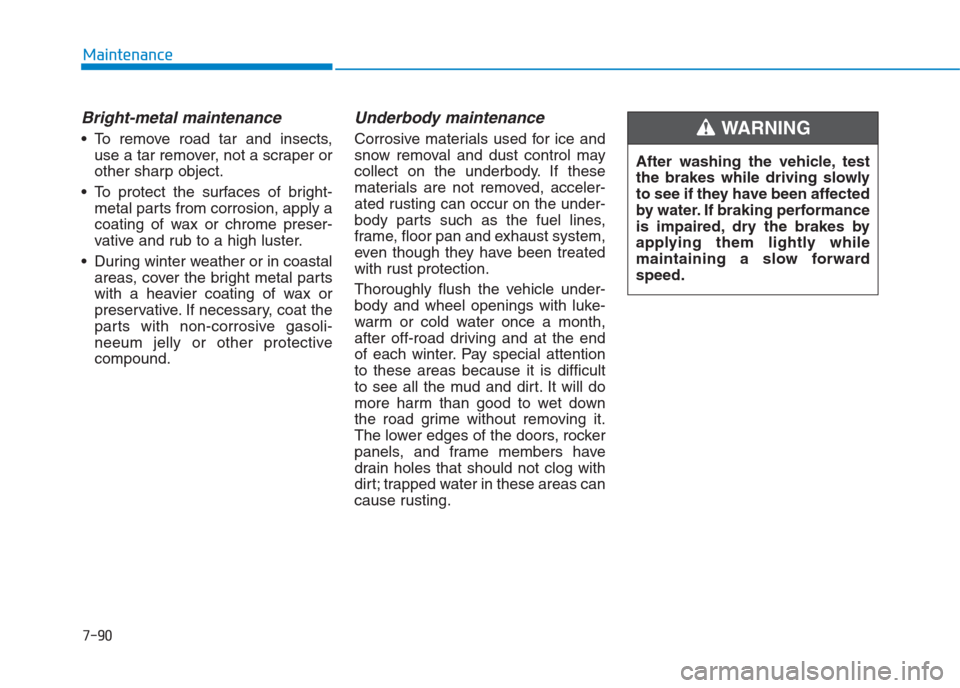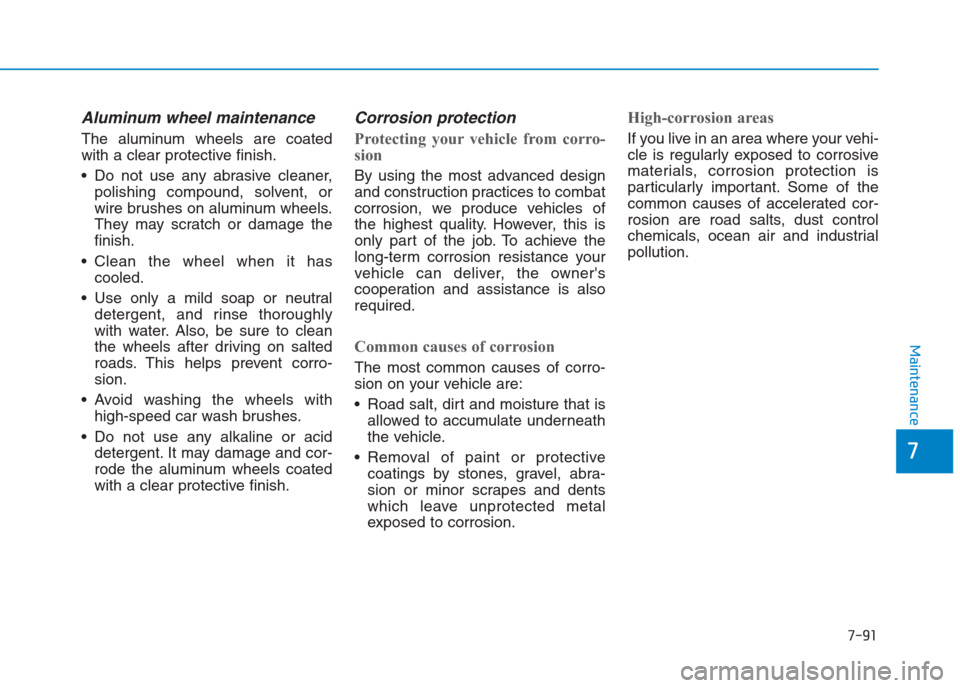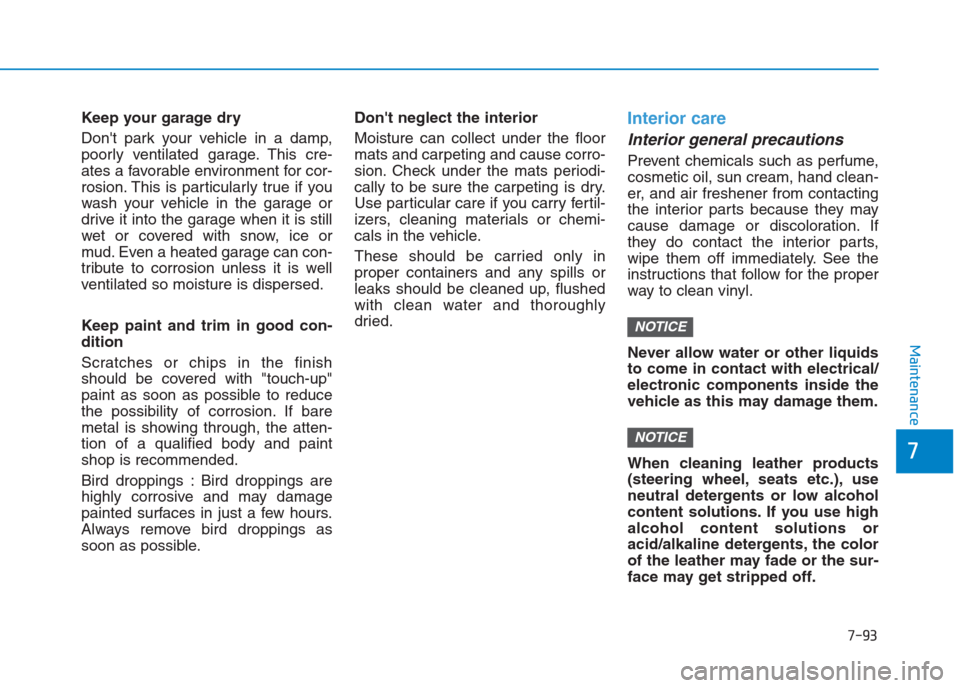2018 Hyundai Creta wheel
[x] Cancel search: wheelPage 447 of 472

7-90
Maintenance
Bright-metal maintenance
To remove road tar and insects,
use a tar remover, not a scraper or
other sharp object.
To protect the surfaces of bright-
metal parts from corrosion, apply a
coating of wax or chrome preser-
vative and rub to a high luster.
During winter weather or in coastal
areas, cover the bright metal parts
with a heavier coating of wax or
preservative. If necessary, coat the
parts with non-corrosive gasoli-
neeum jelly or other protective
compound.
Underbody maintenance
Corrosive materials used for ice and
snow removal and dust control may
collect on the underbody. If these
materials are not removed, acceler-
ated rusting can occur on the under-
body parts such as the fuel lines,
frame, floor pan and exhaust system,
even though they have been treated
with rust protection.
Thoroughly flush the vehicle under-
body and wheel openings with luke-
warm or cold water once a month,
after off-road driving and at the end
of each winter. Pay special attention
to these areas because it is difficult
to see all the mud and dirt. It will do
more harm than good to wet down
the road grime without removing it.
The lower edges of the doors, rocker
panels, and frame members have
drain holes that should not clog with
dirt; trapped water in these areas can
cause rusting.After washing the vehicle, test
the brakes while driving slowly
to see if they have been affected
by water. If braking performance
is impaired, dry the brakes by
applying them lightly while
maintaining a slow forward
speed.WARNING
Page 448 of 472

7-91
7
Maintenance
Aluminum wheel maintenance
The aluminum wheels are coated
with a clear protective finish.
Do not use any abrasive cleaner,
polishing compound, solvent, or
wire brushes on aluminum wheels.
They may scratch or damage the
finish.
Clean the wheel when it has
cooled.
Use only a mild soap or neutral
detergent, and rinse thoroughly
with water. Also, be sure to clean
the wheels after driving on salted
roads. This helps prevent corro-
sion.
Avoid washing the wheels with
high-speed car wash brushes.
Do not use any alkaline or acid
detergent. It may damage and cor-
rode the aluminum wheels coated
with a clear protective finish.
Corrosion protection
Protecting your vehicle from corro-
sion
By using the most advanced design
and construction practices to combat
corrosion, we produce vehicles of
the highest quality. However, this is
only part of the job. To achieve the
long-term corrosion resistance your
vehicle can deliver, the owner's
cooperation and assistance is also
required.
Common causes of corrosion
The most common causes of corro-
sion on your vehicle are:
Road salt, dirt and moisture that is
allowed to accumulate underneath
the vehicle.
coatings by stones, gravel, abra-
sion or minor scrapes and dents
which leave unprotected metal
exposed to corrosion.
High-corrosion areas
If you live in an area where your vehi-
cle is regularly exposed to corrosive
materials, corrosion protection is
particularly important. Some of the
common causes of accelerated cor-
rosion are road salts, dust control
chemicals, ocean air and industrial
pollution.
Page 450 of 472

7-93
7
Maintenance
Keep your garage dry
Don't park your vehicle in a damp,
poorly ventilated garage. This cre-
ates a favorable environment for cor-
rosion. This is particularly true if you
wash your vehicle in the garage or
drive it into the garage when it is still
wet or covered with snow, ice or
mud. Even a heated garage can con-
tribute to corrosion unless it is well
ventilated so moisture is dispersed.
Keep paint and trim in good con-
dition
Scratches or chips in the finish
should be covered with "touch-up"
paint as soon as possible to reduce
the possibility of corrosion. If bare
metal is showing through, the atten-
tion of a qualified body and paint
shop is recommended.
Bird droppings : Bird droppings are
highly corrosive and may damage
painted surfaces in just a few hours.
Always remove bird droppings as
soon as possible.Don't neglect the interior
Moisture can collect under the floor
mats and carpeting and cause corro-
sion. Check under the mats periodi-
cally to be sure the carpeting is dry.
Use particular care if you carry fertil-
izers, cleaning materials or chemi-
cals in the vehicle.
These should be carried only in
proper containers and any spills or
leaks should be cleaned up, flushed
with clean water and thoroughly
dried.Interior care
Interior general precautions
Prevent chemicals such as perfume,
cosmetic oil, sun cream, hand clean-
er, and air freshener from contacting
the interior parts because they may
cause damage or discoloration. If
they do contact the interior parts,
wipe them off immediately. See the
instructions that follow for the proper
way to clean vinyl.
Never allow water or other liquids
to come in contact with electrical/
electronic components inside the
vehicle as this may damage them.
When cleaning leather products
(steering wheel, seats etc.), use
neutral detergents or low alcohol
content solutions. If you use high
alcohol content solutions or
acid/alkaline detergents, the color
of the leather may fade or the sur-
face may get stripped off.
NOTICE
NOTICE
Page 455 of 472

8
Specifications & Consumer information
8
Specifications & Consumer information
8
Dimensions ..............................................................8-2
Engine ......................................................................8-2
Bulb wattage ...........................................................8-3
Tires and wheels ....................................................8-4
Recommended lubricants and capacities ...........8-5
Recommended sae viscosity number ...........................8-7
Vehicle identification number (VIN) ....................8-8
Vehicle certification label .....................................8-8
Tire specification and pressure label .................8-9
Engine number .......................................................8-9
Air conditioner compressor label ......................8-10
Page 456 of 472

8-2
Specifications & Consumer information
D DI
IM
ME
EN
NS
SI
IO
ON
NS
S
Item mm (in)
Overall length 4,270 (168.11)
Overall width 1,780 (70.08)
Overall height 1,630 (64.17) / 1,665 (65.55) *
1
Front tread205/65R16 1,556.5 (61.28)215/60R171,544.6 (60.81)
Rear tread205/65R161,570 (61.81)
215/60R171,558 (61.34)
Wheelbase2,590 (101.97)
*1: with roof rack
Item
U2 1.4 TCIU2 1.6 TCIGamma 1.6 MPI
Displacement
cc (cu. in)
1,396 (85.2)1,582 (97.09)1,591 (97.09)
Bore x Stroke
mm (in.)
75 x 79 (3.0 x 3.1)77.2 x 84.5 (3.04 x 3.33)77 x 85.44 (3.03 x 3.36)
Firing order
1-3-4-21-3-4-21-3-4-2
No. of cylinders
4. In-line4. In-line4. In-line
E EN
NG
GI
IN
NE
E
Page 458 of 472

8-4
Specifications & Consumer information
T TI
IR
RE
ES
S
A
AN
ND
D
W
WH
HE
EE
EL
LS
S
When replacing tires, use the same size originally supplied with the vehicle.
Using tires of a different size can damage the related parts or make it work irregularly.
CAUTION
*1 : Normal load : Up to 3 personsItem Tire size Wheel sizeInflation pressure bar (psi)
Wheel lug nut
torque
kg•m (lb N Normal load *
1Maximum load
Front Rear Front Rear
Full size tire205/65R16 6.0J X 16
230 (33) 230 (33) 250 (36) 250 (36)11~13
(79~94, 107~127)
215/60R17 6.5J X 17
It is permissible to add 3 psi to the standard tire pressure specification if colder temperatures are expect-
ed soon.
Tires typically loose 1 psi (7 kPa) for every 7°C temperature drop. If extreme temperature variations are
expected, recheck your tire pressure as necessary to keep them properly inflated.
An air pressure generally decreases, as you drive up to a high-altitude area above sea level. Thus, if you
plan to drive a high-altitude area, check the tire pressures in advance. If necessary, inflate them to a prop-
er level. (Air inflation per altitude : +10 kPa/1 km)
NOTICE
Page 470 of 472

I-6
Light........................................................................\
......3-78Exterior lights ............................................................3-78
Interior lights .............................................................3-85
Light bulbs ....................................................................7-77\
Headlight, position light, turn signal light, and front fog light bulb replacement .......................7-78
High mounted stop light ............................................7-85
Interior light bulb replacement ..................................7-86
License plate light bulb replacement ........................7-86
Rear combination light bulb replacement..................7-83
Side repeater light bulb replacement .........................7-83
Maintenance services......................................................7-5 Owner maintenance precautions ................................7-5
Owner's responsibility .................................................7-5
Manual transaxle...........................................................5-19 Good driving practices...............................................5-21
Manual transaxle operation .......................................5-19
Mirrors ........................................................................\
..3-38 Inside rearview mirror ...............................................3-38
Outside rearview mirror.............................................3-40 Multimedia system .........................................................4-2
Antenna ........................................................................\
4-2
Bluetooth®Wireless Technology Hands-Free .............4-4
How vehicle audio works ............................................4-5
Steering wheel audio control .......................................4-3
USB and iPod
®port.....................................................4-2
Owner maintenance ........................................................7-8 Owner maintenance schedule .....................................7-8
Parking brake ................................................................7-39 Checking the parking brake .......................................7-39
Recommended lubricants and capacities........................8-5 Recommended sae viscosity number...........................8-7
Index
L
O
P
M
R
Page 471 of 472

I-7
Scheduled maintenance service ....................................7-10
Seat belts .......................................................................2-19
Additional seat belt safety precautions .....................2-27
Care of seat belts .......................................................2-30
Pre-tensioner seat belt ...............................................2-25
Seats ...............................................................................2-2
Front seats ..................................................................2-7
Rear seats ..................................................................2-14
Special driving conditions ............................................5-48
Driving at night..........................................................5-49
Driving in flooded areas ............................................5-50
Driving in the rain .....................................................5-50
Hazardous driving conditions ....................................5-48
Highway driving ........................................................5-51
Rocking the vehicle ...................................................5-48
Smooth cornering.......................................................5-49
Steering wheel ..............................................................3-36
Electric power steering (EPS) ...................................3-36
Horn ...........................................................................3-37
Tilt steering ................................................................3-37Storage compartment ..................................................3-120
Center console storage .............................................3-120
Glove box.................................................................3-121
Sunglass holder ........................................................3-121
Sunroof .........................................................................3-24
Resetting the sunroof .................................................3-26
Sunroof open warning ...............................................3-27
Sunroof opening and closing .....................................3-25
Sunshade ....................................................................3-26
Tilting the sunroof .....................................................3-25
Tailgate .........................................................................3-33
Closing the tailgate ....................................................3-33
Emergency tailgate safety release..............................3-34
Opening the tailgate ...................................................3-33
Theft-alarm system .......................................................3-18
Tire Pressure Monitoring System (TPMS)...................6-10
Changing a tire with TPMS .......................................6-13
Low tire pressure telltale ...........................................6-11
TPMS (Tire Pressure Monitoring System)
malfunction indicator...............................................6-12
I
Index
S
T